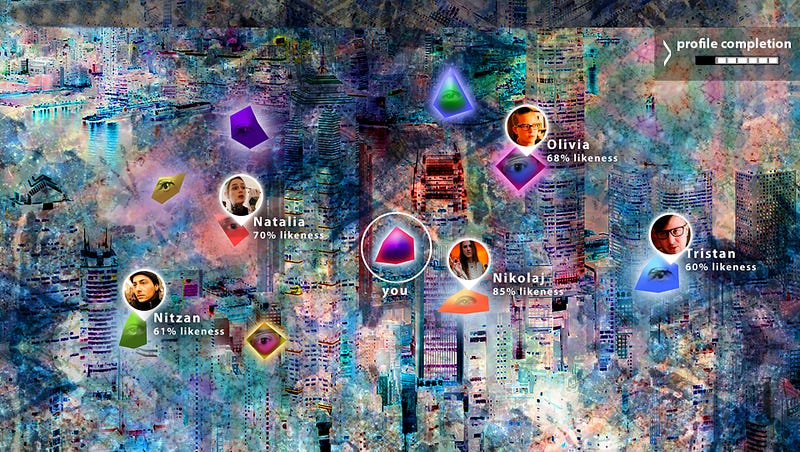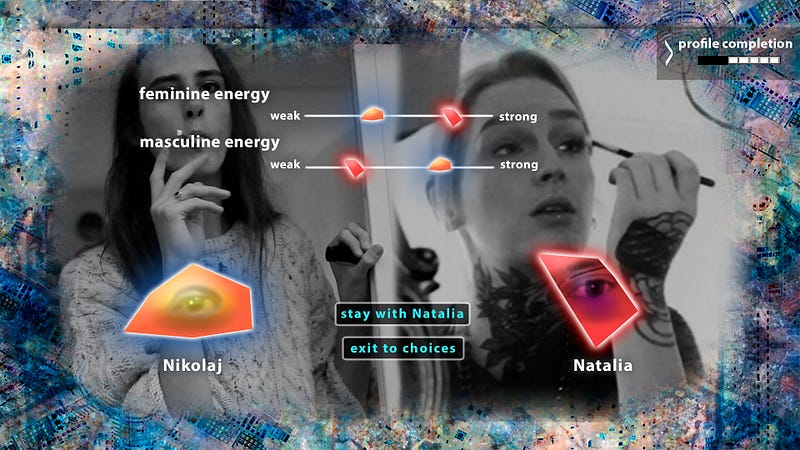
Designing Flux
For the past six years I have been working on Flux, an interactive documentary about deconstructing gender. The project originated from my personal desire to imagine an alternative society where gender is not linked to biological sex. Can we liberate ourselves from expectations based on our physical appearances? Can we change what society mirrors back to us? Can we become aware of the biased roles we unconsciously take? With Flux we hope to ignite an active reflection process and, consequently, an inclusive dialogue about new ways to relate to each other.
The interactive documentary will take the form of an app or a website. Its setting is a journey into a virtual society called “Flux.” In Flux, gender is not determined by biological sex. Instead, people have fluctuating levels of masculine and feminine energies that change in response to different relationships and contexts. Gender is a flow. The idea was inspired by the 1969 science fiction novel The Left Hand of Darkness by Ursula K. Le Guin.
Most of the documentary characters that inhabit Flux want to be free from their biological sex in one way or another. They want to be seen as people. For example, there is performance artist Marie, who is trying to remove her programmed gender through hypnosis. There is a tattoo artist, Natalia, who is perplexed because she chose to physically be a woman and feels strongly connected to other women but doesn’t feel the urge to have children. And bio-artist Tristan, who sees his body as a constantly shifting organism on a micro as well as a macro scale.
When you enter Flux, an omnipresent a-gendered voice guides your journey: “Welcome traveler. We are Flux. We have many shapes and colors, but together we are one. We are always changing. We are me.” The voice is layered and electronically manipulated, so it won’t sound completely human. In Flux everyone is seen as interconnected. The voice reflects this. Visually, the style is a bit psychedelic, built of kaleidoscopic graphics with fluctuating colors. At an early stage of the project, someone referred to it as “a very feminine universe.” At the time, I subconsciously took it as an insult for some reason. Later, I surrendered to this idea and embraced it.
 Graphics
mockup for the ‘choice’ screen
Graphics
mockup for the ‘choice’ screenAt the beginning of the experience you are asked to create a shape based on a self-evaluation of your personality traits. The shape becomes an avatar representing you. The characters in Flux are also represented by shapes based on their personality traits. You will view clips of characters that have more or less likeness to you. The voice continuously comments on your interactions and acknowledges your presence.
It is an open story world that can be explored freely within a timed framework. An initial journey in Flux will take 10–15 minutes. You will be asked to take part in an experiment exploring the concepts of masculinity and femininity. The central questions are: How do we perceive others (the characters)? And what does that say about us?
 Graphics
mockup for the ‘energy level’ screen (not final)
Graphics
mockup for the ‘energy level’ screen (not final)In the “experiment” you will be asked to share your perception of the characters of masculine and feminine energy levels. This will be done by comparing them to each other, since gender is seen as relational in Flux. You also have to place yourself in relation to the characters. Note that it is not a scientific experiment but part of the story experience. The data you enter will be anonymized, saved, and used to build your personal profile, which is revealed when the journey ends. For example, you will see your own feminine and masculine energy levels, based on how you perceived the characters. You will also discover how much your understanding of masculinity and femininity deviates from the norm established by all other players’.
The end goal of the experience is to create awareness of our own gendered programming through an active reflection process. The interactive format allows for this to happen in a playful way. It engages us on a personal level, because we have to actively relate to the people on screen and ourselves.
When we started this project in 2013 there wasn’t any significant discussion about gender in the media. In fact, the producer of Flux and I had to humorously excuse ourselves for presenting a “feminist” project at pitch forums. As we progressed, the media’s focus on gender has increased exponentially. At least in Denmark, where we are based, the media has been overflowing with stories of queer identities in recent years. This development has only made the project more relevant, because users outside of the queer circles are more open to receive it. We certainly don’t have to excuse ourselves anymore.
As a first step, Flux will be published in October 2019 at a special exhibition in Kvindemuseet (The Women’s Museum) in Aarhus, Denmark. An entire floor of the museum will be transformed into an immersive journey into Flux. In our current plans, there will be a tunnel with an audio installation (we call it a “birthing canal”) that you walk through, leading to a dimly lit room. In the room you will be able to sit in a circle around an artificial campfire and play the interactive documentary. When you exit the room, there will be a participatory activity, where you can share ideas for an alternative society. In an adjacent room there will be a multi-sensorial part of the exhibition where visitors can discover objects belonging to the Flux characters (see, smell, or touch) while listening to short audio stories belonging to each of the objects. Note that Flux is still a work-in-progress, so many of the features mentioned above can still change.
Flux is produced by House of Real and was developed with support from MIT Open Documentary Lab, The Danish Film Institute, Sundance New Frontier, The Arcus Foundation, Aarhus Interactive and AVEK. We are currently trying to raise completion funding and are relying on volunteer work for the time being.
Banner photo: Michio Morimoto
Immerse is an initiative of the MIT Open DocLab and The Fledgling Fund, and it receives funding from Just Films | Ford Foundation and the MacArthur Foundation. IFP is our fiscal sponsor. Learn more here. We are committed to exploring and showcasing media projects that push the boundaries of media and tackle issues of social justice — and rely on friends like you to sustain ourselves and grow. Join us by making a gift today.